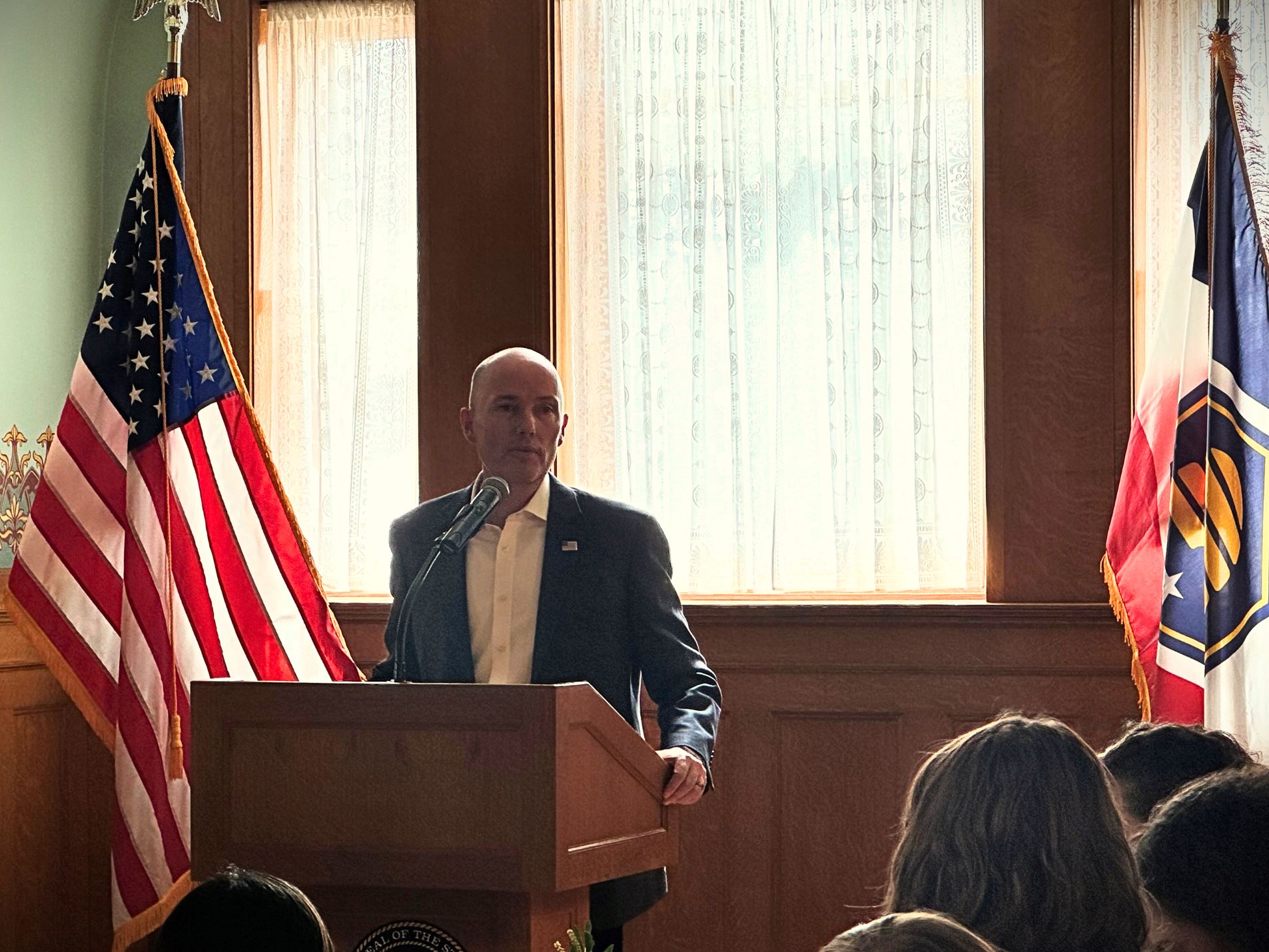Governors are prioritizing digital skill development across the education and training continuum, from K-12 curriculum to upskilling and reskilling for workers and adult learners.
(Download)
Executive Summary
The COVID-19 pandemic dramatically accelerated longstanding trends in the digital transformation of work and workplaces, revolutionizing online service delivery, remote work and workplace digitization across nearly every sector. Estimates suggest the pandemic advanced 10 years of planned technological change in the workplace in less than one year. Yet according to research by the National Skills Coalition, nearly one in three workers in the United States have few or no digital skills, and at least 38 percent of those workers are employed in jobs that require moderate or advanced computer usage. This skills gap creates talent and growth issues for businesses of all sizes — from large companies looking to grow and invest in the United States, to small and mid-size companies that employ the greatest share of workers with low or no digital skills but require a more digitally-skilled workforce to remain competitive.
This rapid digitization of the economy has also exacerbated the digital divide – defined here as the gap between individuals who have access to broadband, connected devices and digital skills and those who do not. This gap creates barriers to equitable economic participation for workers and their families and ultimately poses major risks to economic stability and resiliency at the household, community and state levels. Equipping workers and adult learners (especially those from historically underserved populations) with the digital skills required to succeed in high-quality jobs now and in the future, and access critical workforce services such as unemployment insurance systems and online job postings, is a growing imperative for state workforce systems. As a result, Governors are prioritizing digital skill development across the education and training continuum, from K-12 curriculum to upskilling and reskilling for workers and adult learners. At the federal level, investments in digital equity through the Infrastructure Investments and Jobs Act (IIJA) are providing unprecedented resources for states to advance digital skills and take full advantage of expanded broadband connectivity. Even with this investment, long-term and sustainable solutions to addressing digital skill gaps must go beyond the Act’s provisions and programs.
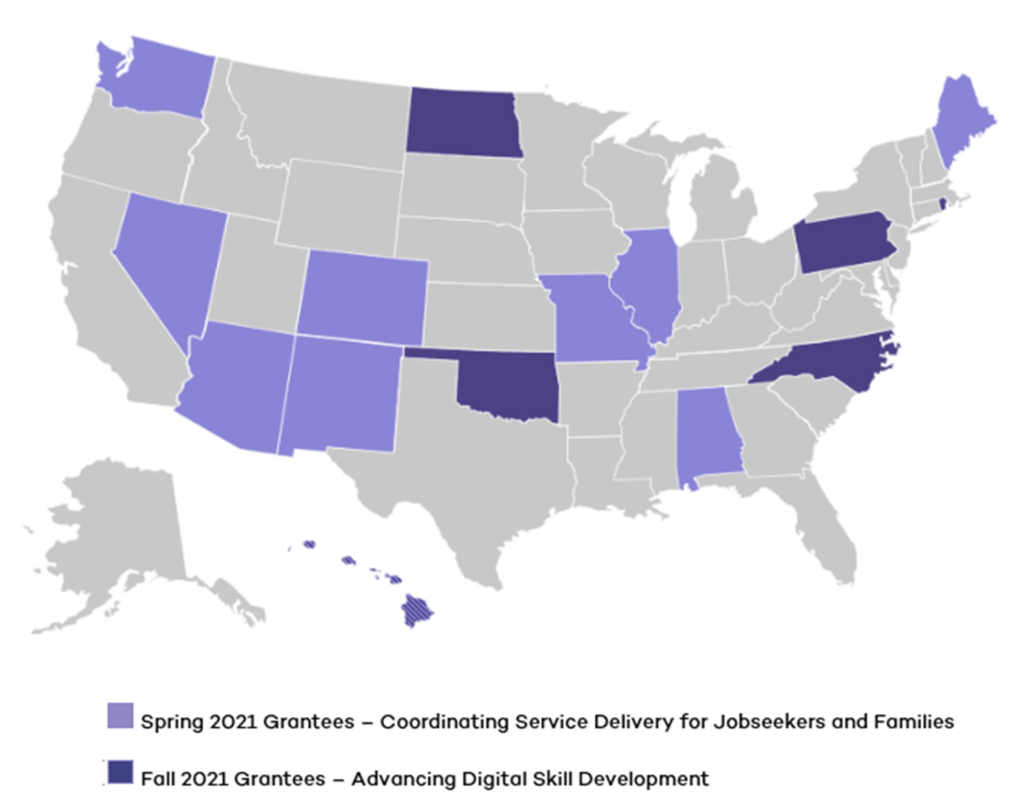
To help states develop innovative, long-term plans to close digital skills gaps, meet employers’ talent needs and develop a workforce that is more resilient in the face of digital transformation, the National Governors Association’s Workforce Innovation Network (NGA WIN) launched its second round of innovation grants to six states in November 2021. NGA WIN awarded Hawai’i, North Carolina, North Dakota, Oklahoma, Pennsylvania and Rhode Island $100,000 each and provided facilitation, guidance and support to state teams as they developed strategic plans to increase access to the digital skills needed to help all individuals in their states fully participate in training, education and work. States applied these resources to support personnel, project coordination and research (including assessing the state’s existing resources for digital upskilling), creating strategies and programs to support digital skill development, and drafting a comprehensive state action plan with policy recommendations to close digital skill gaps in alignment with their Governor’s workforce and economic development goals.
This publication provides lessons learned and case studies for Governors and state policymakers as they work to bridge the digital divide. It begins by highlighting the key activities that are part of the state strategic planning process, including analyzing the state digital skills landscape through data collection, asset mapping and stakeholder engagement. It then details how these planning activities inform the state action plans, including strategies and policies that address elements such as access and equity, partner alignment, data collection, training opportunities, digital navigation and resource allocation. The publication also features information on how states can align their state plans with plans developed for other federal programs such as the Digital Equity Act (DEA) and the Broadband Equity, Access, and Deployment Program (BEAD) program, in-depth profiles of the six grantee states’ innovations, and a framework for creating state plans to advance digital skills.
Key Terms
Digital Equity: The condition in which individuals and communities have the information technology capacity that is needed for full participation in the society and economy of the United States. (Digital Equity Act)
Digital Literacy: The skills associated with using technology to enable users to find, evaluate, organize, create, and communicate information. (Digital Equity Act)
Digital Skills: A range of abilities to use digital devices, communication applications, and networks to access and manage information that enable people to create and share digital content, communicate and collaborate, and solve problems for effective and creative self-fulfillment in life, learning, work, and social activities at large. (UNESCO)
Digital Resilience: The awareness, skills, agility, and confidence to be empowered users of new technologies and adapt to changing digital skill demands. Digital resilience improves capacity to problem-solve and upskill, navigate digital transformations, and be active participants in society and the economy. (Digital US)
Key Activities in the State Planning Process
The state planning process to advance digital skills begins well before policy recommendations are considered and drafted. States may engage in a variety of activities to determine the baseline of the state’s digital literacy, assess needs for the workforce and employers, and gather information that will inform strategic planning and guide the development of state plans to close digital skill gaps.
The following activities were developed by NGA staff for WIN grantees to provide an initial structure for state plan development and can be utilized by other states in their own planning. These activities were designed to equip state teams with valuable information to develop a plan that is truly responsive to the needs of employers, workers, and service providers, and that ultimately bridges the digital divide to promote more equitable economic opportunity. These key activities in state planning processes include:
- Conducting an initial high-level scan of the state’s existing efforts and capacity to address digital skills;
- Adopting definitions, goals and a shared vision;
- Mapping digital skills assets and conducting a gap analysis;
- Compiling and analyzing data on digital skills supply and demand; and
- Engaging a diverse set of stakeholders in plan development
Conduct an initial high-level scan of the state’s existing efforts and capacity to address digital skills
As with all state policy initiatives, it is critical to ground the planning process in a shared understanding of the existing landscape — in this case, the landscape of digital skills and digital equity within the state. While more comprehensive assessments of financial and training assets as well as skill need and attainment data will be necessary as planning continues, states can use readily available tools coupled with a high-level ecosystem scan to gather key information from the outset. The State Digital Equity Scorecard, developed by Microsoft, the National Digital Inclusion Alliance (NDIA) and the National Skills Coalition (NSC), was utilized by all six NGA WIN grantees in their planning process and can be a valuable resource for states beginning their analysis. This tool provides every state with a numerical score based on six indicators (as seen in the image below) related to state efforts to address digital equity. The Scorecard is a first step that can highlight states’ existing capacity and competency on digital skills and digital equity. Additional research to establish a baseline — including information on existing state or local plans, programs, or initiatives that may have digital skills and digital equity components — is also important. There are likely state efforts already underway that can be leveraged to provide a broader understanding of that state’s overall status on digital skills and digital equity, such as state broadband plans or technology-related training programs.
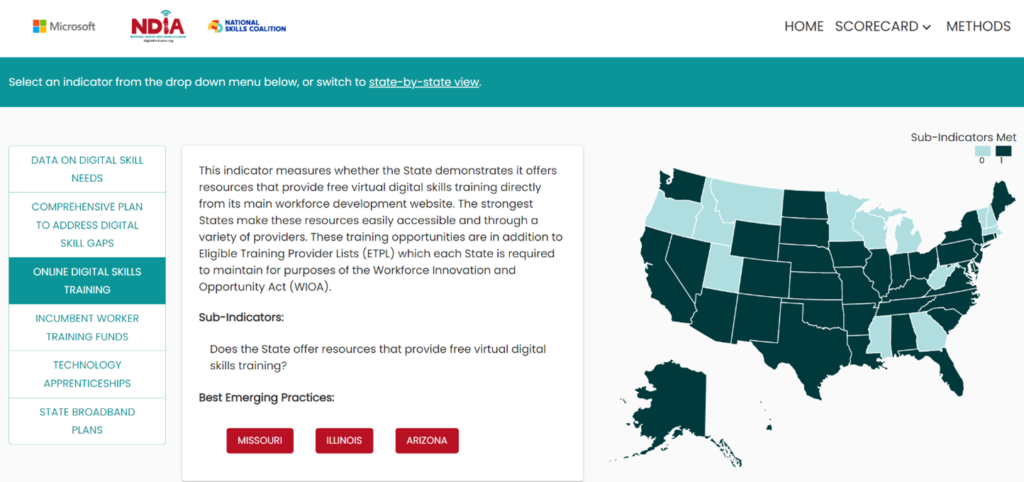
Adopt definitions, goals and a shared vision
Once states have a general understanding of the current ecosystem of digital skills, training programs, plans and initiatives, they can then develop definitions, goals and a shared vision. Developing shared language for concepts such as digital divide, digital equity, digital literacy and digital resiliency can ease communication between partners and ensure that these terms are rooted in the state’s unique conditions and aspirations. In addition to the definitions established in the Digital Equity Act, resources available to states for defining these key terms include those developed by NDIA and those explored in the Digital Resilience in the American Workforce (DRAW) initiative. Using the defined terms, states can then craft a vision for the future of digital skill attainment. Key elements of a state vision may include target populations, scope, level of skill attainment, timeframe, and more. See pages 17-22 for each NGA WIN grantee’s vision. Whether concurrently or following the development of a vision, states may identify shorter-term goals that, when achieved in concert with one another, lead the state toward realizing its broader vision. The definitions, goals and vision will serve as the framework for the remainder of the planning process, so stakeholders should be engaged to ensure these guideposts are reflective of their needs and goals.
Map digital skills assets and conduct a gap analysis
Once states have completed an initial evaluation of existing capacity and developed a vision for digital skill advancement, the next step is to map digital skills assets more comprehensively using a tool such as the State Digital Skill Asset Inventory Tool, developed by NGA and NDIA, and conduct a resource gap analysis. This includes assessing the demand for digital skills, workforce supply of digital skills competencies, and currently available training and educational opportunities. States can consider mapping information such as training and education resources, state and local initiatives, anchor institutions like public schools or libraries, training providers, community champions such as non-profits, service providers, and other assets dedicated to closing digital skill gaps.
NGA WIN grantee Pennsylvania partnered with Thomas P. Miller and Associates (TPMA) to develop the Digital Literacy Programming Map (as seen below), which provides accessible information on digital literacy training opportunities. The map serves a dual purpose: helping the state identify training “deserts” to inform where investments might be made to increase training opportunities; and serving as a public-facing tool for individuals to identify training programs in their area, organizations to connect their clients to resources, and for employers who wish to utilize training providers to advance their employees’ digital skills. Each node includes the name and contact information of the training provider, location, skill level for that program, program cost, and other relevant details.
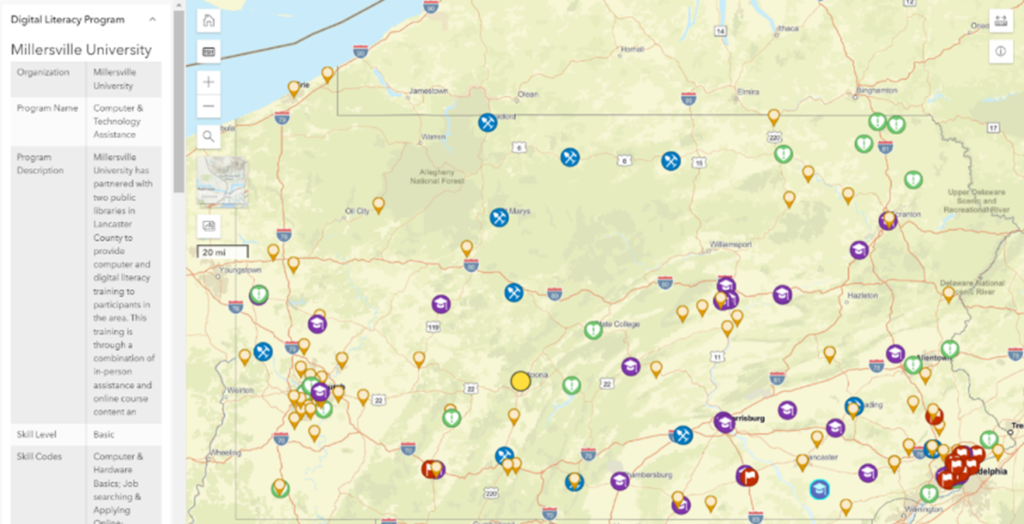
Compile and analyze data on digital skills supply and demand
As states are surveying their digital skills landscape, they may encounter a lack of readily accessible data that directly identifies digital literacy levels for certain populations, the digital skills demands of employers, and the gap between the two. This presents a challenge in determining where and for whom investments in digital skills training are most necessary. NGA WIN’s Using Data To Advance Digital Skills: A State Playbook provides states with recommendations for compiling a variety of existing data sources to inform their state plan, including data on education, employment, the labor market, public benefits, workforce programs and broadband connectivity. Once states have inventoried existing data sources, they may then develop a plan to collect or develop data to fill outstanding information gaps. Importantly, an ideal data landscape will include publicly available and transparent information on programs and credentials that demonstrate positive outcomes in advancing digital skills. With a robust data landscape, states can communicate the impact of improved digital skill levels on workers’ wages, career pathways and job quality, as well as employers’ competitive advantage. Additionally, states can capitalize on new and existing initiatives and goals to both connect digital skill advancement to larger state initiatives, such as postsecondary attainment or rural development, as well as to inform metrics and performance on digital skill attainment. States may also use the information on data gaps and inefficiencies gathered through this process to identify priority areas for improvement that may require new investment, partnerships, or other solutions.
NGA WIN grantee Oklahoma utilized data to tell a compelling story about the impact of digital skills advancement on a worker’s wages. By matching an occupational digital skill scores matrix developed by the Brookings Institution with occupational wage data produced by the U.S. Bureau of Labor Statistics and long-term occupational projections funded by the U.S. Department of Labor, the Oklahoma team found almost three-quarters of current jobs in the state require at least a medium level of digital skills, and that each additional point in a digital score, on a scale of 0-100, is associated with an extra $781 in annual earnings.
Engage a diverse set of stakeholders in plan development
The process of developing a state plan to close digital skills gaps requires thoughtful and consistent stakeholder engagement. Throughout each of the key activities identified above, stakeholders will provide varied and unique perspectives as well as qualitative and quantitative data. Governors and their planning team may consider engaging public sector stakeholders including state agencies of labor, commerce, education, justice, human services, libraries, veterans’ affairs, and others. There are also several stakeholders outside of state government to involve in this process.
Engaging workers and learners in the planning process will ensure plans, policies and programs are more effective at meeting user needs, especially when historically marginalized or underserved populations are intentionally engaged from the outset. These may include people experiencing poverty, justice-involved individuals, people with disabilities, English language learners, Native and Tribal populations, and more. It is also critical to engage non-government partners, who will be essential to carrying out the plan, including training providers, employers, industry associations, community-based organizations, K-12 districts and postsecondary educational institutions. Populations to be considered here are also identified as “covered populations” in the Digital Equity Act.

The Digital Equity Act also requires robust stakeholder engagement throughout the planning and execution stages of its programs, so establishing relationships and developing trust will be beneficial for both the DEA programs (as described further in pages 15-16) as well as the state’s broader strategic planning process to advance digital skills over both the short and long term. States will also benefit from establishing ongoing feedback loops with these stakeholders for regular engagement and data collection that ensures state efforts, policies and programs are achieving the desired impact and are responsive to evolving needs. Planning teams will also benefit from making the plan, data and programmatic information accessible to a wider stakeholder audience, including federal, state and local legislators, policymakers and the public, as this will increase broad awareness, transparency and buy-in as well as allow these partners to leverage the information collected through the state planning process.
NGA WIN grantee Rhode Island prioritized and executed a robust, iterative stakeholder engagement strategy throughout their planning process. Stakeholders included community leaders, residents, incarcerated individuals, digital skills training providers and participants, employers and philanthropic groups who provided their input through interviews, focus groups, surveys and other forums throughout the process of gathering information and drafting their state plan. As a result, the state plan that the Rhode Island team developed is both representative of current digital skills and literacy challenges and opportunities and will remain responsive as technology, skills and demands shift in the future.
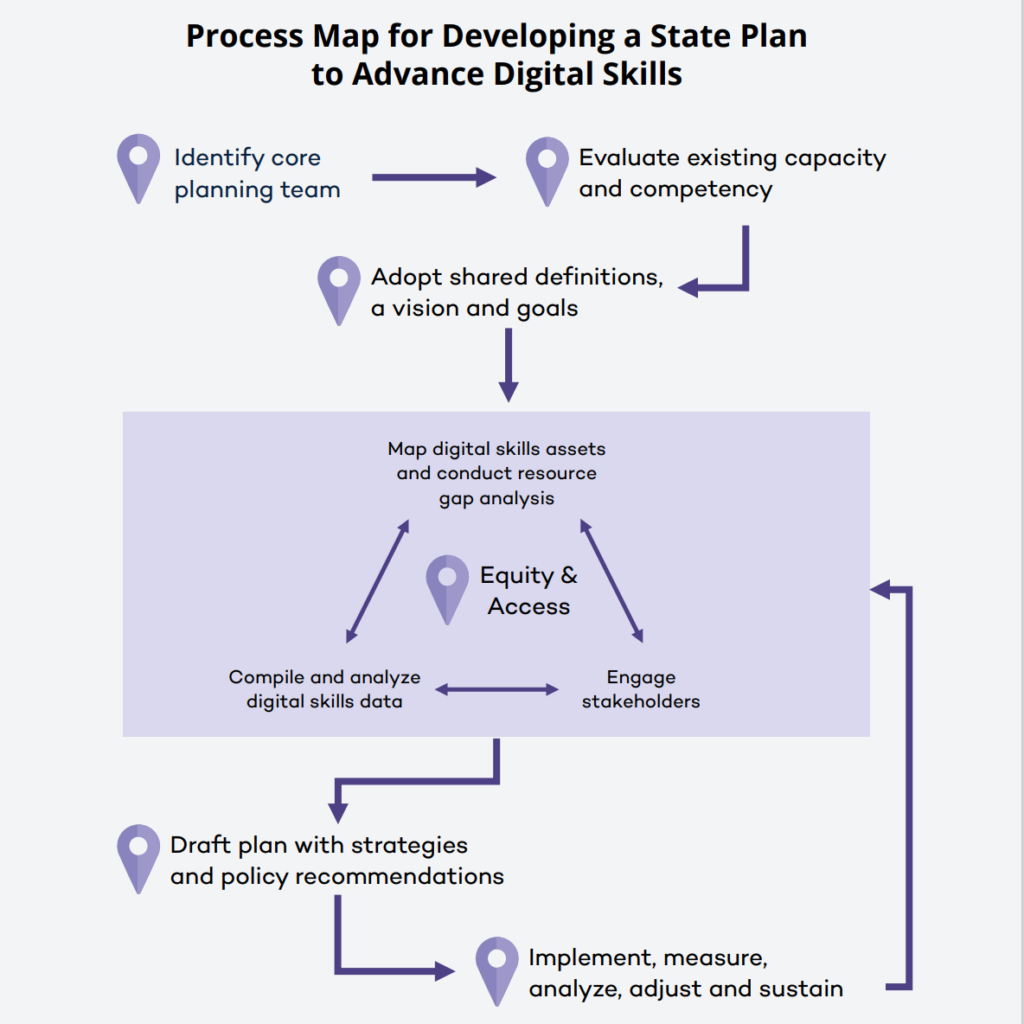
The process map outlined above reflects broadly applicable best practices for state strategic planning developed through decades of NGA Center for Best Practices work to facilitate these processes across policy areas, citing most recently the process completed with NGA WIN state grantees as described in this report, as well as state strategic planning process maps developed in NGA’s 2018-2020 Future Workforce Now initiative and in the NGA 2021 State Roadmap for Workforce Recovery.
Key Elements of State Plans to Advance Digital Skills
Closing state digital skills gaps requires a blend of policies, programs and initiatives contained in a comprehensive plan that unites partners around a common vision and goals, informed by the key activities discussed previously. These plans serve to guide state efforts to advance digital skills but also exist as living documents to be updated as states’ needs and capacity evolves. Effective state plans acknowledge and provide for a continuum of digital upskilling throughout workers’ careers as technology and skills demands change. The following key elements offer a menu of policy areas to consider as states develop strategies and policy recommendations to advance digital skills. While all of these elements may be necessary for a long-term comprehensive plan, states should first consider which areas are most essential to address the unique needs of their state and meet their shared vision and goals. For a complete guide to developing a state plan to advance digital skills (including a policy recommendation template), please reference Appendix A: State Policy Plan Framework for Advancing Digital Skills.
Access and Equity
The increasing digitization of the economy has exacerbated the opportunity gap between those who have access to resources to improve their digital literacy and skills and those who do not. The DEA provides a set of covered populations including individuals who are members of a racial or ethnic minority group, veterans, incarcerated individuals, individuals who reside in a rural area and more. States may consider how to embed principles of access and equity in their policy recommendations, especially for the DEA-specified covered populations, and develop strategies to increase equitable access to training and services. Resources such as NSC’s Applying a Racial Equity Lens to Digital Literacy, JFF’s Advancing Access and Digital Equity: Challenges and Solutions and the DRAW initiatives. Findings from a National Landscape Scan on Adult Digital Literacy Instruction can provide states with actionable steps to address questions of access and equity for target populations.
Strategies to improve access and equity regarding digital skills include:
- Leveraging existing state policies or gubernatorial executive orders regarding equity to drive broader access to digital skills programs and resources
- Developing targeted digital skills programs, partnerships and resources for key demographic groups, regions or occupations that historically lack access and opportunity
- Including metrics on access and equity as a part of new or existing data collection and analysis efforts, and reporting on digital skills development
NGA WIN grantee North Dakota sought to capture a full picture of the digital connectivity and literacy levels of underserved populations in the state throughout their data compilation, analysis and plan development process. To achieve a comprehensive assessment, the North Dakota team developed a series of maps highlighting counties with the highest concentration of veteran, rural and Tribal populations. By layering these new maps with the state’s broadband connectivity map, the North Dakota team identified the need for connectivity and digital upskilling programs in counties with large Tribal populations, which have historically lacked access to these resources. Leveraging these data sets allowed the North Dakota team to target this population and make a recommendation in their state plan to engage with Tribal partners to identify digital skill gaps and training opportunities.
Alignment, Partnership and Sustaining Momentum
Aligning partners around a shared vision and coordinating efforts across public and private entities is critical to implementing state strategies to advance digital skills. States may consider policy recommendations for partnership, systems improvement and infrastructure development that are necessary to build and maintain a digitally resilient workforce.
Examples of policy recommendations or strategies to foster alignment, partnership and sustained momentum include:
- Designating a lead state agency or coalition of partners to be responsible for coordinating implementation of the state plan to advance digital skills
- Naming public or private partners as the lead for specific recommendations or activities that fall within their existing efforts or expertise
- Embedding or aligning digital skills goals with other state initiatives including those related to broadband, workforce development, economic development, K-12 education, postsecondary education, immigrant integration and more
NGA WIN grantee Hawai’irecognized the imperative for coordinated leadership of the state’s work to advance digital skills and recommended designating a Digital Workforce Hui in their state plan to close digital skills gaps. Building on the successful model of the Hawai‘i Broadband Hui as a convener for collaboration on broadband solutions, the Digital Workforce Hui will include state agencies involved in digital skills education and training, and will be led by the Hawai’i Broadband and Digital Equity Office in partnership with the Hawai’i State Public Library (both of which were members of Hawai’i’s NGA WIN team). The Digital Workforce Hui will be responsible for implementing the state’s plan to close digital skills gaps and driving alignment with the state’s vision for digital skill advancement. This includes additional work such as: supporting community-based organizations to incorporate digital literacy into their goals and programs; developing pathways and tools for the progression from foundational literacy to digital literacy to occupational digital skills; creating a plan to digitally upskill and increase equity and access in the public sector workforce; and executing a digital skills communication campaign to excite and inspire residents to be a part of the digital workforce future.
Data Collection, Performance Assessment and Continuous Improvement
A robust plan to collect and analyze digital skills data can provide states with valuable information to adapt and respond to the evolving needs of workers and employers. States can leverage new and existing data sources to ensure their strategies to advance digital skills are data-driven and to develop goals for digital skill attainment. While the initial data compilation and analysis efforts for planning will supply states with a baseline of information, it is important to develop strategies that promote ongoing data collection and analysis. This long-term, iterative process allows states to evaluate their progress toward identified goals for digital skill attainment and measure and improve outcomes for digital skills programming.
Examples of policy recommendations or strategies to facilitate data collection as well as performance assessment and improvement include:
- Identifying key performance indicators for digital skill attainment, and leveraging regularly collected data on wages, occupational supply and demand, broadband access and more to inform and assess these metrics
- Using a digital literacy assessment tool to fill gaps in existing data
- Engaging with stakeholders such as employers, workers and community-based organizations to collect qualitative data on digital skills needs, readiness and resources, and building feedback loops to ensure ongoing engagement
New or Expanded Digital Skills Training Opportunities
Advancing digital skills often requires the expansion of existing training opportunities and/or the creation of new programs and services. Upon completion of a gap analysis of training availability, skills competencies and labor supply and demand, states may consider which successful models for advancing digital skills are best suited to be scaled, which existing, well-vetted digital skills curricula may be adopted, if it may be necessary to establish new programs or curricula, and opportunities to integrate digital skills into existing workforce training programs.
Examples of policy recommendations or strategies to create or expand digital skills training opportunities include:
- Expanding successful digital skills programs to areas or populations with identified gaps and increasing the capacity of existing community-based programs
- Leveraging local partners, such as community-based organizations, American Job Centers or adult education providers when creating new programs to ensure local needs and barriers are considered and addressed
- Engaging employers in curriculum development to align digital skills training with in-demand competencies and credentials
Digital Navigation
Expanding digital navigation services can provide workers and families with critical information to access affordable internet, devices, and digital literacy and digital skills training. To help close the digital skills gap, states may consider policy recommendations and strategies to invest in digital navigation infrastructure that can serve as a key connector between individuals and the resources they need to increase their digital skills.
Examples of policy recommendations or strategies to support digital navigation services include:
- Partnering with community-based organizations to build a network of trusted digital navigators
- Implementing “train-the-trainer” models to expand the statewide capacity of digital navigators by leveraging existing resources and ensuring consistency in service delivery
- Developing a marketing strategy to raise public awareness of digital navigation services
Digital Navigators
Digital navigators are trusted guides who assist community members in internet adoption and the use of computing devices. Digital navigation services include ongoing assistance with affordable internet access, device acquisition, technical skills, and application support. (National Digital Inclusion Alliance)
NGA WIN grantee North Carolina prioritized digital navigation in their state plan to close digital skills gaps by including recommendations to establish both state-level leadership and on-the-ground digital navigation infrastructure. The team set three goals for digital navigation: leverage federal dollars to fund digital equity programs across the state (including digital navigation); empower community-based organizations to provide digital skills training and digital navigation services; and use existing state assets as “working laboratories” to train and connect workers with high-paying digital careers.
North Carolina’s strategies to meet these goals include: using American Rescue Plan Act (ARPA) funds to launch a competitive grant program housed in the North Carolina Department of Information Technology’s Office of Digital Equity and Literacy to fund digital navigation projects; establishing a state digital navigator position to develop and maintain a digital literacy resources website and coordinate with local digital navigators; and developing a network of “working laboratories” within a 45-60-mile radius of the most underserved or unserved areas to provide residents a safe location, safe connection and devices to utilize broadband for telehealth, online classes, training or remote work.
Funding and Resource Allocation
Many of the policy recommendations and strategies suggested above may require funding to support the implementation and sustainability of state efforts to advance digital skills. This may include leveraging federal funds available through legislation such as the Digital Equity Act (DEA) or the Broadband Equity, Access, and Deployment Program (BEAD), workforce funding streams such as the Workforce Innovation and Opportunity Act (WIOA) or the Strengthening Career and Technical Education for the 21st Century Act (Perkins V), or state-funded workforce development programs.
As states consider options for funding digital literacy and digital skill development, several principles may help inform the allocation of state resources now and in the future:
- Flexibility: The influx of federal funding through new, time-bound grant programs such as DEA and BEAD or through more permanent programs like WIOA provides an opportunity and mandate for advancing digital skills. However, state-funded programs may have greater flexibility and utility than federal programs in terms of allowable uses, reporting requirements and the ability to invest in programs and resources that meet the state’s unique needs for digital skills.
- Sustainability: Continued support for state plans to close digital skills gaps is critical to maintain momentum and ensure progress toward shared goals and metrics. While federal programs such as DEA and BEAD provide multi-year funding and structure, state funding can provide a sustainable source of support as states plan for ongoing implementation and evolution of digital literacy and digital skills initiatives beyond the time-limited window for federal programs.
- Resilience: Digital literacy and digital skills training is an iterative process of upskilling workers over the course of their careers as technology and employer needs evolve. Investments in programs that train for skills that are currently in-demand or only upskill workers to a limited level of attainment do not account for the continuum of digital skills needed to foster digital resilience in a state’s workforce. State funding can be used to plan for and respond to evolving digital skills needs to ensure that workers across demographics, geographies and industries are prepared for the future of work.
For example, Pennsylvania is currently in the third round of their Digital Literacy and Workforce Development Grants, which are funded by the WIOA Governor’s reserve fund. These awards to local workforce development boards, public libraries, non-profits and small businesses, particularly in areas of poverty or low digital literacy, support digital literacy classes emphasizing career development skills. Supported training is focused on digital fundamentals, digital job seeking, digital citizenship and digital information.
For more information on funding streams to support digital skill development, please reference Appendix B: Funding to Advance Digital Skills.
Aligning State Plans to Advance Digital Skills and Planning for the Digital Equity Act (DEA) and Broadband Equity, Access, and Deployment (BEAD) Program
While Governors and state policymakers are planning to advance digital skills, the federal government has also recognized the need for robust and comprehensive investments in digital upskilling and digital equity. This has manifested in the Digital Equity Act (DEA) and Broadband Equity, Access, and Deployment Program (BEAD) of the Infrastructure Investment and Jobs Act (IIJA). DEA and BEAD provide a historic level of funding for planning and implementation of programs to provide equitable access to high-speed internet and the training necessary to fully access and utilize that connectivity. This offers a timely opportunity for states to advance digital skills that align with DEA and BEAD planning to amplify and sustain their combined impact. While state digital skills plans and programs may exceed the scope and five-year timeframe of DEA and BEAD, these programs include a mandate and funding to achieve common goals that support state visions for digital skill development, and these principles for alignment may be applied to any future federal investment in digital skills.
Identify and build relationships with partners leading DEA and BEAD planning
There will likely be overlap in the groups involved with DEA and BEAD planning, but it is critical that those working on planning for these two programs build awareness of one another’s work to ensure goals and activities are aligned to the extent possible and to take advantage of existing stakeholder networks and available data. To better coordinate planning efforts and avoid duplication, state teams developing and implementing state plans to advance digital skills should identify and connect with the agencies and teams leading their state’s work on DEA and BEAD planning. This alignment and information-sharing will ultimately lead to greater collective impact for all three plans.
Leverage and expand stakeholder engagement efforts
Throughout the process of developing a state plan to close digital skills gaps, states will likely have engaged a wide range of stakeholders, from workers to employers to service providers. DEA and BEAD also require states to engage a diverse group of stakeholders in developing digital equity plans, which provides an opportunity for states to leverage their existing network of stakeholders and build on their previous engagement and data collection on digital skills needs and competencies. By including stakeholders who are involved in digital skills work, states can ensure digital literacy and digital skill advancement remain a priority as they work to address digital equity more broadly. It is critical to involve stakeholders in both the planning and implementation phases of these federal programs and look to them to identify challenges and successes in equitable access to digital skills training resources. Many of the service providers in the stakeholder network may also provide valuable information on lessons learned in overcoming barriers to access digital services to apply to other digital equity efforts. As discussed previously, states can also use the regular feedback loops they establish with stakeholders on digital skill advancement to ensure DEA and BEAD plans reflect evolving needs, and to regularly assess progress toward identified goals and metrics.
For more information on engaging employers specifically on DEA planning, please see NGA and UpSkill America at the Aspen Institute’s brief, Leveraging The Digital Equity Act To Advance Digital Skills: A Guide For Business Leaders To Partner With State Policymakers.
Align existing state plans and programs with DEA and BEAD goals and metrics

State plans to advance digital skills can include a broad vision with long-term strategies that look beyond federal programs, but they should also be aligned with the goals and metrics of time-limited programs like DEA and BEAD. The DEA Notice of Funding Opportunity (NOFO) for the State Digital Equity Planning Grant Program requires states to identify barriers to digital equity as well as measurable objectives for documenting and promoting digital literacy access to services in their State Digital Equity Plan. The DEA also requires State Digital Equity Plans to assess how their objectives will “impact and interact with the State’s (i) economic and workforce development goals, plans, and outcomes; (ii) educational outcomes; (iii) health outcomes; (iv) civic and social engagement; and (v) delivery of other essential services.” Likewise, the BEAD NOFO for the Five-Year Action Plan requires states to identify needs, goals, and implementation strategies for digital equity and inclusion, which includes digital skills. To the extent possible, aligning goals and metrics for digital literacy and digital skill development across these three plans can increase coordination among partners implementing strategies to meet those goals. This alignment can also ensure sustainability of efforts to advance digital skills and literacy beyond the limited timeframe for the DEA and BEAD programs, which is essential for continued workforce competitiveness as digital skill needs are continuously and rapidly evolving.
State Innovations in Planning to Advance Digital Skills
(* Indicates state team lead)

Hawai’i
State Team: Friends of the Library of Hawai’i, Hawai’i Broadband Hui, Hawaii Department of Business, Economic Development & Tourism, Hawai’i Literacy, Hawai’i State Public Library System*, Hawai’i Workforce Development Council, Office of Governor David Ige
Vision: Hawai’i is known as a place where people learn.
Digital equity has been a top priority for Hawai’i and for Governor David Ige’s administration, leading the state to develop a broadband strategic plan and adopt a Digital Equity Declaration outlining a vision, goals and priorities to move Hawai’i toward a more equitable digital future. The state also conducted the Hawai‘i Digital Literacy and Readiness Study which assessed the digital literacy and readiness of the state’s workforce across segments of the population including demographics, education, occupation, industry and geography. The Hawai’i NGA WIN team sought to expand on this work by developing a comprehensive plan to achieve a 100% digitally literate workforce that has the skills to adapt to the continuously changing job market and economy.
To gather qualitative and quantitative data on the digital skills gap in their state and to engage communities on their needs and priorities for a plan to advance digital skills, the Hawai’i team conducted a comprehensive stakeholder engagement process that included one-on-one interviews, focus groups, roundtables and surveys with employers, workers, community-based organization, labor leaders and industry specialists. These conversations surfaced a multifaceted definition for digital readiness in Hawai’i as well a continuum for digital upskilling. These definitions helped to shape a plan to advance both individuals’ digital skills and the public system’s capacity to support those individuals. Outreach to organizations providing digital literacy and digital skills training also led to the development of the iterative Hawai‘i Digital Skills Training Resources map.
The Hawai’i team’s five-year state plan to advance digital skills emphasizes five key strategies: designate a Digital Workforce Hui; invest to grow existing programs; track longitudinal and skills-specific metrics; designate the Hawai’i State Public Library System as a hub for digital skills learning; and continue building the digital skills resources map. The Digital Workforce Hui will lead the implementation of the strategies and sub-strategies laid out in their state plan as well as coordinate among partners to ensure sustainability of their efforts to achieve their shared vision.
“My vision for the state includes a broad shift to a diversified economy with a focus on digital access and equity so all in our community have the tools needed to thrive in today’s digital world.”
Governor David Ige

North Carolina
State Team: North Carolina Department of Information Technology*, North Carolina Business Committee for Education, North Carolina Community College System, NCWorks Commission, Office of Governor Roy Cooper, State Library of North Carolina
Vision: All North Carolinians will be empowered to participate in the digital economy fully and equitably by increasing access to and awareness of digital literacy education and skills training.
Like many states, the COVID-19 pandemic exposed digital inequities between North Carolinians, including access to affordable high-speed internet and the skills needed to take advantage of broadband connectivity. Governor Roy Cooper has made digital equity a priority for his administration, creating a plan to close the digital divide in North Carolina by 2025 and establishing the nation’s first Office of Digital Equity and Literacy (ODEL) to coordinate digital literacy efforts and digital skills training statewide. Building on this investment, the North Carolina NGA WIN team sought to develop strategies to provide access to digital skills resources and training through data-driven coordination among state, local and private partners.
To address their state’s unique barriers and prioritize activities for their state plan to close the digital skills gap, the North Carolina team identified three areas of focus early on in their work: system infrastructure and partner alignment; digital skills training on career pathways for in-demand occupations; and community and stakeholder engagement and awareness. Additionally, the North Carolina team prioritized two key deliverables from the outset: including developing a virtual hub for digital skills training and creating a Digital Navigator position in ODEL to lead work on the virtual hub and collaborate with communities across the state in digital equity planning. The team also deployed a statewide survey of employers to assess digital skills attainment and needs in the state’s workforce, providing valuable data to quantify the digital skills gap.
North Carolina’s plan to close the digital skills gap contains policy recommendations and strategies that support alignment and partnership, data collection and performance improvement, and digital navigation and resource development. Key recommendations include: establishing a working group to coordinate digital literacy and digital skills programming across state agencies; partnering with community-based organizations to conduct focus groups and listening sessions with digitally-excluded populations; implementing data collection tools to capture a more robust picture of digital skills needs; determining targets for job readiness and job creation and aligning digital skills metrics with those targets; training and connecting residents with FAST TRACK, high-paying digital careers, and employment opportunities.
“Without access to digital skill development opportunities, gaps in career, education and health care opportunities will only widen. Keeping North Carolina at the forefront of digital innovation and workforce development is critical to our state’s continued success.”
Governor Roy Cooper

North Dakota
State Team: North Dakota Department of Commerce*, North Dakota Department of Public Instruction, Office of Governor Doug Burgum, North Dakota Workforce Development Council
Vision: All North Dakotans will have equitable access to opportunities to develop digital skills to meet the needs of North Dakota’s 21st Century workforce.
North Dakota’s position as the top state in the country for providing high-speed fiber optic access, according to the U.S. Department of Agriculture Rural Development, provided the North Dakota NGA WIN team with a foundation to expand the state’s digital inclusion work to advance digital skills. To better understand the state’s connectivity landscape, the North Dakota team partnered with the Dakota Carrier Network, a collective of rural broadband service providers, to access a broadband connectivity map. After assessing statewide connectivity and connectivity for underserved populations, including veterans and Tribal communities, the team compiled additional data in partnership with Job Service North Dakota, the Department of Public Instruction and others. The team used the data they complied to assess additional factors such as internet speeds, digital skill gaps among adult learners and jobseekers and the potential return on investment for workers who increase their digital skills. This process surfaced two key findings: the “in-demand” jobs on the North Dakota Job Service website have higher average digital skills requirements than the average for all occupations and increasing a North Dakotan’s “digital skills score” by one point on a scale of 0-100 can increase annual income by an average of just under $660.
Using these insights, the North Dakota team prioritized upskilling the workforce to meet employer needs while also improving workers’ economic opportunity by advancing digital skills. In their state plan to close digital skills gaps, the North Dakota team recommended the appointment of a Digital Equity Director, who will be responsible for overseeing the state’s digital equity efforts, aligning partners and policy, data collection and program evaluation. The plan also included a recommendation to increase the number of people utilizing state services or programs who receive fundamental digital skills training. The plan identified several agencies including workforce system partners, human services agencies, state libraries and others that should include foundational digital skills training in their training or assistance programs.
“North Dakota’s economy is changing more rapidly than ever in part due to advancements in technology. A skilled workforce is vital to our success as a state. North Dakota leads the nation in providing high-speed connectivity for its residents, so we are well-positioned to pursue this opportunity to advance digital equity throughout the state.”
Governor Doug Burgum
Oklahoma

State Team: Office of Governor J. Kevin Stitt, Oklahoma Department of Human Services, Oklahoma Employment Security Commission*, Oklahoma State Senate
Vision: Create economic opportunities that transform the rural workforce to meet the foundational and occupational digital skills demands of today’s workforce.
The Oklahoma NGA WIN team recognized early on in their process that Oklahoma, like many other states, has a challenge in connecting residents, and specifically workers, with access to broadband and the skills they need to utilize the internet for all that it has to offer. In some regions of the state, particularly in rural counties, broadband access is not currently available, accessible or reliable enough to allow residents to fully participate in life and the economy. Additionally, the Oklahoma NGA WIN team recognized that there was also a distinct lack of digital skills in more rural areas of the state, where broadband may have recently become available and has not been widely adopted. As a result of this analysis, the Oklahoma team chose to focus their state plan to advance digital skills on rural Oklahomans and their communities.
The Oklahoma team leveraged their state Labor Market Information office to develop a narrative about the impact that connecting rural Oklahomans to remote working opportunities could have on the economic opportunity for those families as well as their communities. By analyzing publicly available labor market data, the team was able to demonstrate that each additional point added to a worker’s “digital skills score,” on a scale of 0-100, is associated with an extra $781 in annual earnings. In rural Oklahoma, the impact of becoming more digitally literate could directly impact the ability to afford living expenses.
As part of their state plan to advance digital skills, the Oklahoma team developed a pilot project to connect rural Oklahomans to high-quality jobs in the digital economy. The team is partnering with an Oklahoma employer to identify jobseekers who live in rural areas and are interested in remote work. They will then conduct digital skill assessments to connect those jobseekers either to immediate employment based on their skills, or to digital skills training to prepare them for future employment with the business partner. The team will specifically target rural Oklahomans who receive unemployment insurance benefits or who are long-term unemployed and will leverage existing reemployment services to connect these jobseekers to digital skills training. Lessons learned from the pilot project will help the Oklahoma team continue to develop wider-reaching digital upskilling opportunities, especially for rural jobseekers and other underserved populations.
“Bridging the digital skills gap is critical to growing and maintaining a thriving workforce in Oklahoma. I’m proud to support our state’s efforts to find innovative ways to bring digital training and quality jobs to as many Oklahomans as possible.”
Governor Kevin Stitt

Pennsylvania
State Team: Office of Governor Tom Wolf*, Pennsylvania Department of Community and Economic Development, Pennsylvania Department of Education, Pennsylvania Department of Labor and Industry, Pennsylvania Workforce Development Board*, Team Pennsylvania
Vision: Within the next five years, Pennsylvanians will have the abilities needed to fully, safely, and responsibly participate in a society reliant on digital technology and the Internet. Each Pennsylvanian will have the ability to use—and the ability to continue to learn to use—frequently changing devices and software platforms, and to find, access, organize, evaluate, create, and communicate information competently and confidently enough to accomplish that individual’s needs of living, learning, and working.
From the outset of their project, the Pennsylvania NGA WIN team strove to align their activities and priorities with those of the newly created Pennsylvania Broadband Development Authority. The collaboration and integration of these efforts grounded the team’s work and promoted discussion about the best means of ensuring those who were already connected, and especially those who would be gaining access, would have the ability to digitally upskill. The Pennsylvania team carefully considered whether to target specific populations with their plan to advance digital skills and whether to focus on foundational or occupational digital skills. Through a comprehensive data collection and analysis and stakeholder engagement process, the Pennsylvania team determined that the needs of their residents and employers would be best served by a concerted effort on digital upskilling for foundational digital literacy for all Pennsylvanians.
The Pennsylvania team prioritized an assessment of the statewide digital skills landscape to better understand currently available training opportunities as well as the digital skills needs of employers. To gather this information, the team launched an employer survey that received over 350 responses and provided valuable insight including that “slightly fewer than half of respondents agreed with the phrase, ‘My employees’ digital skills needs are met.’” To better understand the Commonwealth’s digital skills training infrastructure, the Pennsylvania team contracted with TPMA to build a training asset map. This map, which will soon be made public, will allow policymakers and service providers to determine areas and populations that lack digital literacy and digital skills training resources and make investments in those communities. To support these efforts, the Pennsylvania team included a policy recommendation in their plan to “identify and engage anchor institutions that serve as trusted entities within communities to provide foundational digital literacy skills training or connect people to training opportunities.”
“Broadband availability and devices have little meaning if people do not have the skills to use these tools to accomplish tasks in a digital world. Advancement of digital skills must be discussed in the context of broadband and device access for a holistic approach to address digital gaps.”
Governor Tom Wolf

Rhode Island
State Team: Office of Governor Dan McKee, Office of Lieutenant Governor Sabina Matos, Providence Public Library, Rhode Island Commerce, Rhode Island Department of Education, Rhode Island Governor’s Workforce Board, Rhode Island Office of the Postsecondary Commissioner, Skills for Rhode Island’s Future*
Vision: To support digital equity through access to high-speed internet, appropriate devices, and digital skill development that ensures an equitable Rhode Island economy.
The Rhode Island NGA WIN team, with a diverse cohort of members, sought to capitalize on the state’s focus to create an equitable and opportunity-rich economy by improving equity and access to digital skills. The vision adopted by the Rhode Island team includes goals for the state, the workforce and workplace, the digital skills service delivery ecosystem as well as individuals. This intersectional, crosscutting approach to addressing the digital skills gap resulted in a process that was rooted in stakeholder engagement and centered the Rhode Islanders who would be impacted by digital upskilling efforts.
Rhode Island’s plan to close the digital skills gap was informed by a robust data compilation and analysis effort, which included stakeholder interviews, focus groups and surveys. To bolster the anecdotal and qualitative data, the Rhode Island team reviewed and considered adult basic education training program data, American Community Survey and other federally compiled data, recent state and local reports on broadband access and digital skills, as well as information from community-based service providers.
Following months of engagement and reflection, Rhode Island’s state plan to advance digital skills contains policy recommendations and strategies that promote systems-level action to close the digital skills gap. Key recommendations from the plan include: encouraging the Broadband Advisory Council to integrate policy, planning, and funding for high-speed internet, device access, and skills training; developing a common framework for assessing and addressing the digital equity gap; building the capacity of the digital skills training ecosystem; and developing a statewide data repository that inventories, tracks, measures, and monitors progress toward achieving digital equity, among others.
“During the pandemic, households had increased reliance on digital connectivity, and access to such became essential for employment, education and daily activities. It is our intent to tackle barriers to access for low-and moderate-income households assuring they have reliable and affordable high-speed internet at home for critical resources and information.”
Governor Dan McKee
About the NGA Workforce Innovation Network
The National Governors Association Workforce Innovation Network (NGA WIN) is a nonpartisan learning and action collaborative for state leaders who have demonstrated strong commitments to developing a resilient workforce. The initiative is dedicated to building state capacity for near-term innovation and longer-term strategy development to prepare state workforces for a post-COVID-19 economy. NGA WIN was launched in January 2021 in partnership with its founding sponsor, the Cognizant Foundation. NGA WIN is an initiative of the Workforce Development and Economic Policy Program in the NGA Center for Best Practices (NGA Center).
Acknowledgements
The NGA Center thanks the Governors and state workforce system leaders who participated in the second cohort of NGA WIN. Without their leadership and commitment to sharing best practices, this publication and other NGA WIN resources would not be possible. The NGA Center would also like to thank the Cognizant Foundation, Intel, Microsoft, Walmart and Western Governors University for their sponsorship and partnership, as well as the NGA WIN Advisory Network for their partnership in supporting Governors and state policymakers and their thoughtful review of this publication. This publication was prepared by Sophia Yager and Jordan Morang, policy analysts at the NGA Center, with guidance and direction by Rachael Stephens, program director for workforce development and economic policy at the NGA Center. The authors thank their colleagues Katherine Ash, Jack Porter and Katie Nichols for their contributions to this publication and to the success of NGA WIN.












